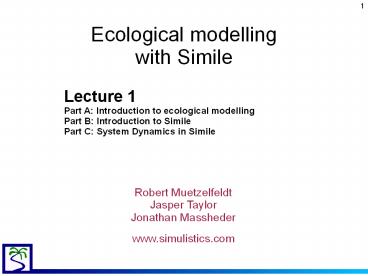Ecological%20modelling%20with%20Simile - PowerPoint PPT Presentation
Title:
Ecological%20modelling%20with%20Simile
Description:
1. Ecological modelling. with Simile. Robert Muetzelfeldt. Jasper Taylor. Jonathan Massheder ... How to model (using Simile as the modelling platform) ... – PowerPoint PPT presentation
Number of Views:102
Avg rating:3.0/5.0
Title: Ecological%20modelling%20with%20Simile
1
Ecological modelling with Simile
Lecture 1Part A Introduction to ecological
modellingPart B Introduction to SimilePart C
System Dynamics in Simile
Robert MuetzelfeldtJasper TaylorJonathan
Massheder www.simulistics.com
2
Aims of course
- How to model (using Simile as the modelling
platform) - How to use Simile to model (for those with
experience in modelling) - Raise awareness of possibilities
- Role of modelling in the research community
3
Part AIntroduction to ecologicalmodelling
4
Core concepts
- Purpose
- Idealisation
- Design
- Syntax
- Semantics
- Modelling paradigms
5
Purpose
- a model for..., not a model of...
- PredictionManagementTesting understanding
- Problems when purpose is not clearly defined
e.g. IBP models
6
Idealisation
- The simplification needed to satisfy our purpose
- No need to apologise for an appropriately-simplifi
ed model
7
Design
- cf architectural design map making
- Design criteriaaccuracy, use of data, cost of
development, ease of use, simulation speed,
understandability - Constrained by available building blocks
8
Syntax
- The elements of the design language vocabulary
- How they can be put together grammar
9
Semantics
- What do the building blocks mean?
- What constitutes good model design?
- How does the model relate to real-world objects
and relationships?
10
Modelling paradigms
- Paradigm a conceptual framework within which
scientific theories are developed - A school of thought within which the modeller
operates - ExamplesSystem Dynamics differential
equationobject-based multi-agentstatistical
probabilisticrule-based cellular
automatonlinear programming discrete-event
11
Compartment-flow (System Dynamics) is a good
paradigm for ecological modelling because...
- it builds on existing concepts
- it's diagrammatic
- it's in widespread use
- it encourages a layered approach (conceptual
structure before mathematical detail) - it's applicable to a wide range of ecological and
environmental problems - it's a suitable basis for computer modelling
software
12
Object-oriented modelling is a good paradigm for
ecological modelling because
- theres a close correspondence between the
objects in the real world and the objects in the
model. - it reflects the idea that many individuals follow
the same rules. - it enables us to talk about the hierarchical
composition of some ecological system. - it enables us to describe relationships between
things (shading, closeness, ownership). - it enables processes of creation and destruction
of things to be represented in a natural way.
13
Part BIntroduction to Simile
14
Background to Simile
- DFID/FRP Agroforestry Modelling Project
- Undergrad/MSc teaching
- FLORES
- ModMED
- Commercialisation
15
Simile key features
- Combines System Dynamics and object-based
modelling approaches - Intuitive graphical user interface
- Highly-efficient simulations (in C)
- Supports modular modelling
- Customisable input/output tools
- Open format (Prolog/XML) for saved models
16
Modelling concepts supported by Simile
- System Dynamics
- Differential/difference equations
- Age/size/sex/species classes
- Objects multiple, create/destroy, associations
- Spatial layers, grid, polygons etc
- Modularity
17
Sample screen display (classic)
18
Sample screen display (new)
19
(No Transcript)
20
The Desktop
21
The Equation Dialogue
22
The sketch-graph window (1)
23
The sketch-graph window (2)
24
The sketch-graph window (3)
25
Run Control and Helper windows
26
Some display helpers
27
Part CSystem Dynamics in Simile
28
(No Transcript)
29
(No Transcript)
30
(No Transcript)
31
(No Transcript)
32
(No Transcript)
33
(No Transcript)
34
(No Transcript)
35
Compartments and flows
36
Choice of substance (1)- biomass only
37
Choice of substance (2)- biomass and numbers
38
Multiplesubstances? - use multiplecompartments
39
Making your first model
- System Dynamics models (in Stella, ModelMaker)
- cycle diagrams (energy, nutrient, hydrological
cycles) - Differential/difference-equation models
- Design your own
40
(No Transcript)
41
(No Transcript)































